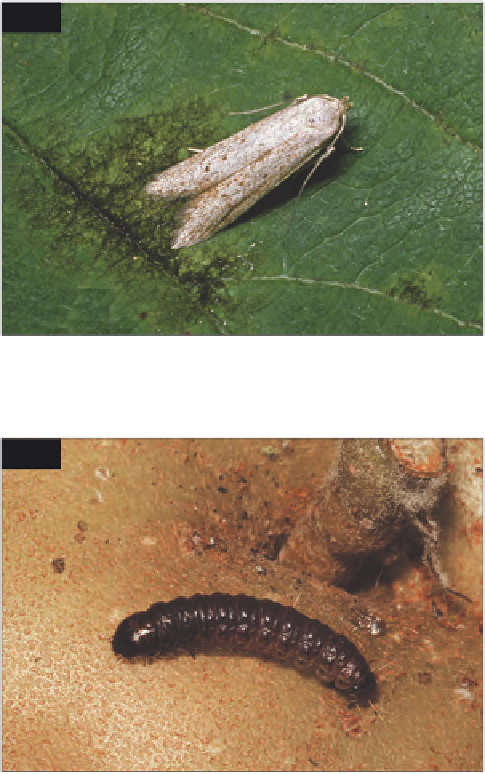Biology Reference
In-Depth Information
Family
TORTRICIDAE
(tortrix moths)
Blastobasis decolorella
(Wollaston) (
609-610
)
Straw-coloured apple moth
A subtropical species of Madeiran origin, now
established in parts of Europe where it sometimes causes
damage in orchards, attacking tree bark and the maturing
fruits; the larvae also feed on various other trees and
shrubs, including ornamentals such as
Rhododendron
.
Adults and larvae are similar in appearance to those of
Blastobasis lignea
, but the former more uniformly
coloured, the wings being mainly pale ochreous yellow,
and the latter purplish brown.
A large and important group of small, relatively broad-
winged moths, including several well-known pests. The
larvae have well-developed thoracic legs and five pairs
of abdominal prolegs, each proleg bearing a complete
circle of similarly sized crotchets; many species have an
anal comb with which particles of frass are ejected from
the anus. Larvae often feed in spun or rolled leaves,
wriggling backwards rapidly if disturbed. Pupation
takes place in the larval habitation or elsewhere, the
pupa protruding from the cocoon following emergence
of the adult.
Acleris rhombana
(Denis & Schiffermüller)
(
611-612
)
Rhomboid tortrix moth
An often common pest of trees and shrubs, including
crab-apple (
Malus
), hawthorn (
Crataegus
), flowering
cherry (
Prunus
), ornamental pear (
Pyrus calleryana
'Chanticleer') and rose (
Rosa
); often present in gardens
and nurseries. Widely distributed in central and northern
Europe; also present in North America.
609
DESCRIPTION
Adult:
13-19 mm wingspan; fore wings with a sub-
falcate tip, dark reddish brown to ochreous with darker
markings, a reticulate pattern and, sometimes, a distinct
central scale tuft; hind wings light grey, darker in
female.
Egg:
0.8
0.5 mm; flat, oval and yellowish
green.
Larva:
up to 14 mm long; greyish green or
yellowish green, with pale inconspicuous pinacula;
prothoracic plate reddish brown or green; anal plate
light green; anal comb yellowish; thoracic legs black.
Pupa:
7-9 mm long; reddish brown or dark brown;
cremaster short and broad.
×
609
Straw-coloured apple moth (
Blastobasis decolorella
).
LIFE HISTORY
Adults occur from August to October. Eggs are laid
singly or in small batches on the bark of trunks and
branches. They hatch in the spring. Larvae then invade
the opening buds. Later they feed in webbed leaves,
usually at the tips of the young shoots. Larvae also feed
on blossom trusses. Pupation takes place in June or
early July, usually in a cocoon spun in the soil. The
pupal stage is protracted, and lasts for six to eight weeks
or more.
610
DAMAGE
Restricted mainly to the loss or distortion of younger
leaf tissue and blossoms but with little or no effect on
tree growth.
610
Larva of straw-coloured apple moth (
Blastobasis
decolorella
).

Search WWH ::

Custom Search